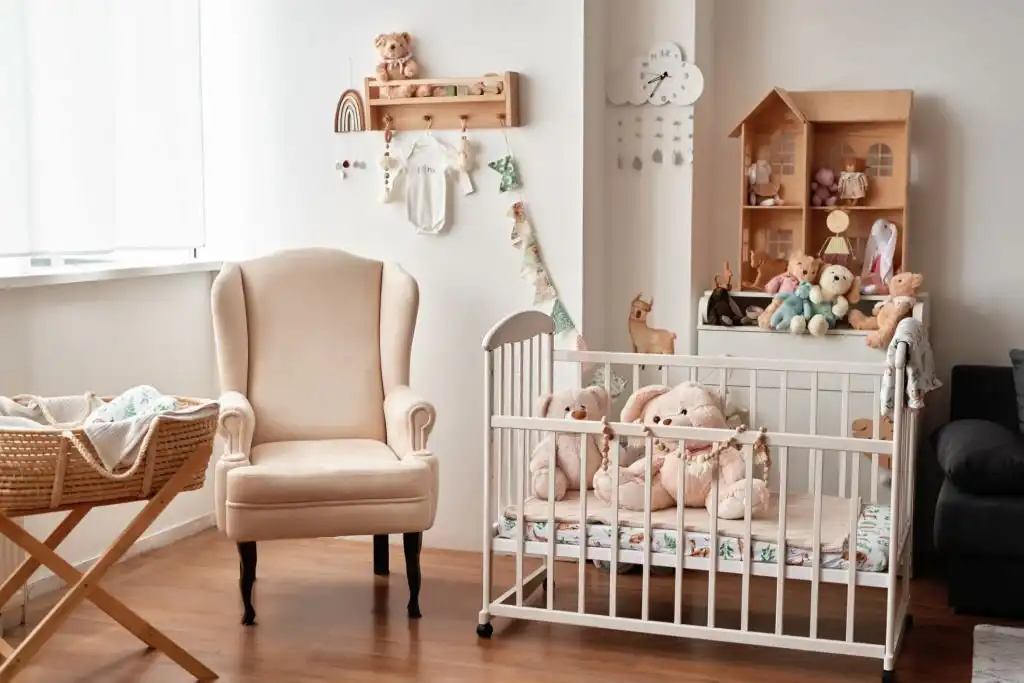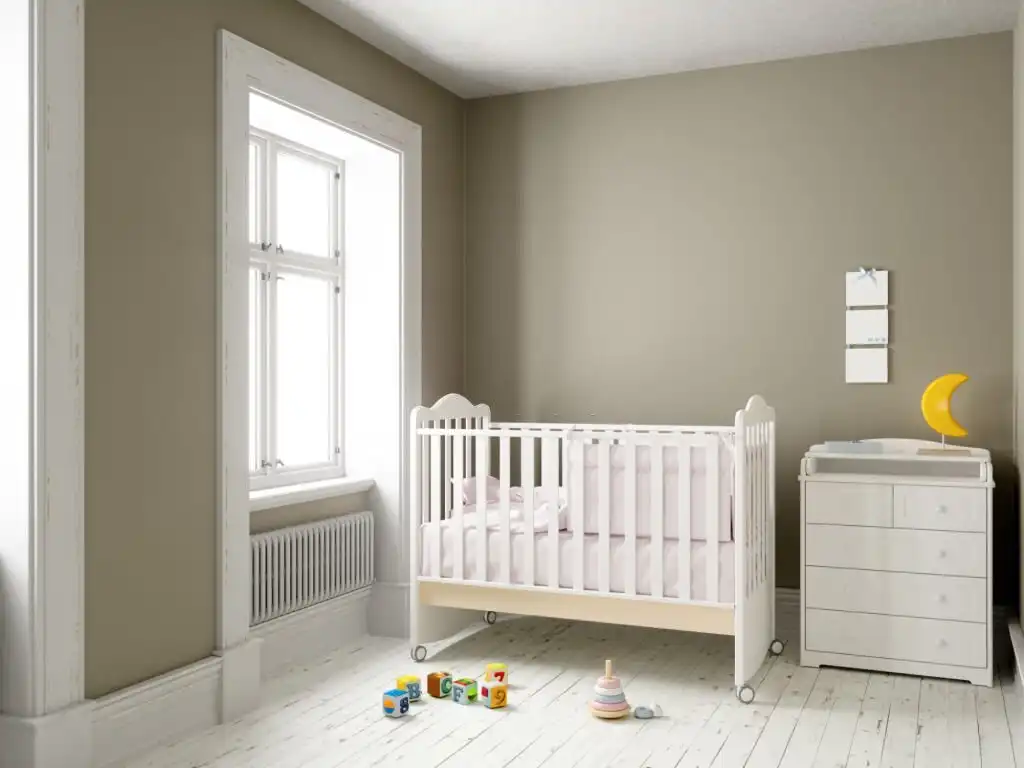Baby Nursery Safety Tips: Keep Your Little One Secure

Welcoming a new baby into the world is an exciting and life-changing experience. As a new parent, you want to do everything you can to make sure your little one is safe and comfortable. Creating a safe and secure nursery environment is one of the most important ways to protect your baby.
However, setting up a nursery can be overwhelming, especially regarding safety concerns. Many factors must be considered, from choosing the right crib to keeping the room free from hazards.
In this article, we’ll share our top baby nursery safety tips to help you create a safe and comfortable space for your little one. Whether you’re a first-time parent or an experienced caregiver, these tips will help you feel confident that your baby is protected from harm.
Choosing a Safe Crib

Choosing a safe and sturdy crib is one of the most important decisions when setting up your baby’s nursery. Here are some tips to keep in mind:
Choose a crib that meets current safety standards. Look for a Juvenile Products Manufacturers Association (JPMA) certification to ensure the crib meets federal safety standards.
Make sure the slats on the crib are no more than 2 3/8 inches apart. This will prevent your baby from getting its head or limbs stuck between the slats.
Avoid drop-side cribs, which have been banned since 2011 due to safety concerns.
Ensure the mattress fits snugly in the crib, with no gaps between the mattress and the crib’s sides. This will prevent your baby from getting stuck between the mattress and the crib.
Setting Up a Safe Sleeping Environment
Once you’ve chosen a safe crib, setting up a safe sleeping environment for your baby is important. Here are some tips to keep in mind:
- Always place your baby on their back to sleep, which has been shown to reduce the risk of Sudden Infant Death Syndrome (SIDS).
- Avoid placing soft objects in the crib, such as pillows, blankets, or stuffed animals, which can pose a suffocation hazard. Instead, dress your baby in a wearable blanket or sleep sack for warmth.
- Make sure the room temperature is comfortable for your baby, between 68 and 72 degrees Fahrenheit.
- Use a firm, flat mattress with no gaps between the bed and the crib’s sides.
- Keep the crib free from any toys or loose bedding, which can pose a suffocation hazard.
Securing Furniture and Decor
In addition to choosing a safe crib and setting up a safe sleeping environment, securing any furniture and decor in the nursery is important to prevent accidents. Here are some tips to keep in mind:
- Anchor any tall furniture, such as bookshelves or dressers, to the wall to prevent them from tipping over.
- Ensure all cords and wires are out of your baby’s reach, and use cord covers to keep them organized and secure.
- Choose non-toxic paint and finishes for any furniture or decor in the nursery to prevent your baby from being exposed to harmful chemicals.
- Keep any small objects or decorative items out of your baby’s reach, as they can pose a choking hazard.
Baby Proofing the Room

Once you’ve taken steps to secure the furniture and decor in the nursery, it’s important to baby-proof the room to prevent accidents. Here are some tips to keep in mind:
- Cover any electrical outlets with safety plugs or outlet covers to prevent your baby from sticking their fingers or objects into them.
- Keep cleaning supplies or other hazardous materials out of your baby’s reach in a locked cabinet or high shelf.
- Install window guards or safety netting on any windows to prevent your baby from falling out.
- Use door stoppers to prevent fingers from getting pinched in doors.
Common Safety Hazards to Avoid
In addition to the above tips, there are several common safety hazards to avoid in your baby’s nursery. Here are some things to keep in mind:
- Avoid using crib bumpers, which can pose a suffocation hazard and increase the risk of SIDS.
- Never leave your baby unattended on an elevated surface, such as a changing table or dresser.
- Don’t use any baby products that have been recalled or have a history of safety concerns.
- Avoid using baby monitors with cords, which can pose a strangulation hazard.
Additional tips to ensure your baby’s safety in the nursery
Keep all cords and wires out of reach of your baby. This includes cords for blinds, curtains, and electronics. Use cordless window coverings or install cord safety devices to prevent accidental strangulation.
Make sure all furniture in the nursery is sturdy and won’t tip over easily. Secure dressers, bookcases, and other large items to the wall using brackets or anchors.
Check the nursery’s temperature regularly to ensure it’s not too hot or cold. A comfortable temperature range is between 68-72 degrees Fahrenheit (20-22 degrees Celsius).
When choosing nursery decor, opt for non-toxic and hypoallergenic materials. Avoid any items that could be a choking hazard, such as small trinkets or toys.
Remember, as your baby grows and becomes more mobile, you may need to adjust your safety measures accordingly. Stay vigilant and keep an eye out for any new hazards that may arise.
In addition to these tips, educating yourself on infant CPR and choking rescue techniques is important. Consider taking a class or watching instructional videos online to prepare for an emergency.
Considering these baby nursery safety tips, you can create a safe and secure environment for your little one to grow and thrive in. Don’t hesitate to ask for help or advice from trusted family members, friends, or healthcare providers if you have any questions or concerns about your baby’s safety.
Also Read:
Verdict
Creating a safe and secure nursery environment protects your little one from harm. By following these baby nursery safety tips, you can feel confident that you’ve taken the necessary steps to keep your baby safe and sound in their crib and play area.
Remember to choose a safe and sturdy crib, set up a safe sleeping environment, secure furniture and decor, baby-proof the room, and avoid common safety hazards. With some planning and preparation, you can create a comfortable and safe nursery for your baby.
FAQs
Do I need to buy a brand-new crib for my baby, or is a used one okay?
If you’re buying a used crib, ensure it meets current safety standards and has not been recalled. Check for any signs of wear or damage, and replace any missing or broken parts.
Is it safe to use a crib mobile?
Yes, it is safe to use a crib mobile as long as it is securely attached and out of your baby’s reach.
How often should I check the nursery for safety hazards?
It’s a good idea to check the nursery regularly for safety hazards, such as loose cords or unsecured furniture. Make it a part of your regular cleaning routine.
How to keep a child safe in a nursery
Keeping a child safe in a baby’s nursery is a priority for any parent or caregiver. Here are some tips to help ensure a safe and secure environment for your little one:
Use a firm and well-fitted mattress: Make sure the mattress in your baby’s crib is firm and fits snugly against the crib’s sides. This will prevent your baby from getting trapped between the mattress and the crib.
Avoid soft bedding: Avoid using soft bedding such as pillows, blankets, and stuffed animals in the crib. These items can pose a suffocation hazard to your baby.
Keep the crib clear: Keep the crib clear of any toys, bumper pads, or other objects your baby could use to climb out of the crib or become tangled.
Use a baby monitor: Use a baby monitor to keep an ear out for your baby’s movements and sounds, even if you’re in the same room.
Install window guards: Install window guards on any windows in the nursery to prevent your child from falling out.
Secure cords and wires: Keep cords and wires for blinds, lamps, and other electronic devices out of your child’s reach.
Check the temperature: Make sure the temperature in the nursery is comfortable for your baby and that the room is well-ventilated.
Use a safety gate: If your nursery has a door, use a safety gate to keep your child from wandering out of the room.
